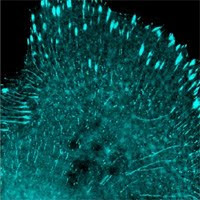New Product of the Week: Anti-GFP Polyclonal Antibody 100ug ABP-PAB-PAGFP10 $175.00.
Allele Biotech has introduced the highly efficient GFP-Trap for GFP fusion protein pull-down, and a monoclonal anti-GFP antibody for detecting GFP-fusion proteins after Immunoprecipitation with GFP-Trap. Just launched this week, the anti-GFP polyclonal antibodies provide an alternative method for analyzing the isolated proteins.
Pre-announcement: Allele Biotech will launch a FAQ and a User Forum online where you can also find common protocols in focus areas and exchange ideas with us or others.
1. Thaw one vial of irradiated feeder cells by swirling gently in 37oC water bath until all of the contents are thawed. One vial of 2×106 cells is sufficient to prepare two10-cm dishes, or two 6-well or 12-well plates (about 3-4×104/cm2).
2. Spray vial with 70% ethanol and wipe dry before placing in tissue culture hood.
3. Gently add 1 ml prewarmed feeder cell medium (alphaMEM or DMEM/F12 with 10% FBS), mix with contents of cryovial and transfer into 15-ml conical tube containing 4 ml prewarmed feeder cell medium.
4. Centrifuge the cells at 200g at room temperature for 5 min and discard the supernatant.
5. Resuspend the feeder cells in 12 ml feeder cell medium. If using a 6-well plate: add 1 ml of feeder cell suspension to each well of the 6-well plate containing 1 ml fresh feeder cell media per well. If using a 10-cm tissue culture dish: add 6 ml of feeder cell suspension to 10-cm tissue culture dish containing 6 ml fresh feeder cell media. If using a 12-well plate: add 0.5 ml feeder cell suspension to each well of 12-well plate containing 1 ml fresh feeder cell media per well. Gently shake the dish left/right and up/down 10-20 times without swirling the plate to evenly distribute the cells across the plate.
6. Incubate the cells in 37 1C, 5% CO2, overnight.
CRITICAL STEP When moving the feeder cell plates from the tissue culture hood to incubator, do not swirl the medium, as this tends to cause the cells to accumulate in the center. Immediately after placing the plates in the incubator, slide the plates forward and backward (2–3 cm) two times, then left to right (2–3 cm) two times to ensure equal distribution of the cells. Use within 5–7 days.
7. Split stem cells (~2.5 x 105 to 5 x 105 cells, or ~10% confleuce) into plate with feeder cells. Aspirate medium from ESC or iPSC, wash with PBS and add 0.5 ml of 0.05% trypsin. Incubate at 37oC, 5% CO2, for 5 min.
8. Inactivate trypsin with 3 ml stem cell medium, and collect cell clumps in 15-ml conical tube avoiding making single cell suspension because ESC tends to die in single cell form.
9. Centrifuge at 200g at room temperature for 4 min.
10. Aspirate feeder medium from feeder plates (cells incubated in Step 6), rinse with one ml of stem cell medium and add 5 ml of stem cell medium and return to incubator.
11. Aspirate and discard supernatant from the conical tube in Step 8, resuspend cells in 5 ml stem cell medium, gently dispense the cell pellet three times, add to feeder cell wells or dishes.
12. Incubate stem cells grown on feeder cells at 37oC, 5% CO2, for 48 h.
13. Aspirate medium and replace with stem cell medium every day; if iPSC colony number is low, replace medium every two days.
Friday, October 16, 2009
Protocols for Using Human Fibroblasts Expressing Human bFGF as Feeder Cells for iPSCs
Labels:
bFGF,
DMEM/F12,
FAQ,
feeder cells,
forum,
human fibroblasts,
iPS cells,
iPS protocol,
iPSCs
Subscribe to:
Post Comments (Atom)




No comments:
Post a Comment